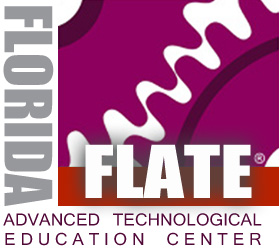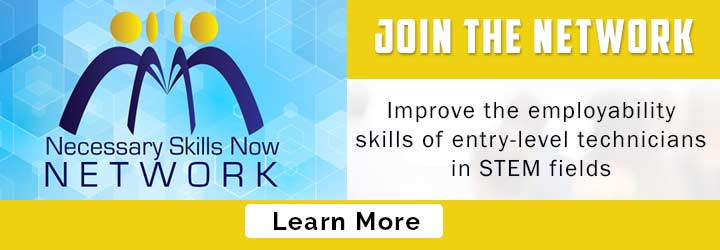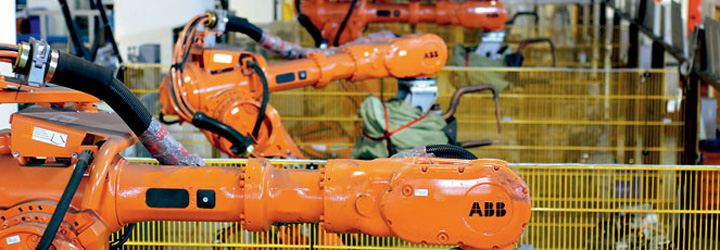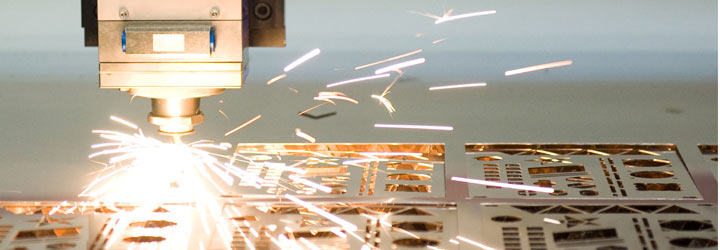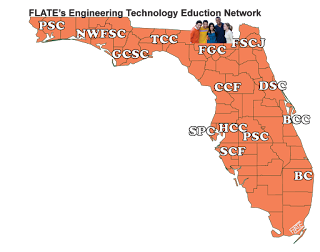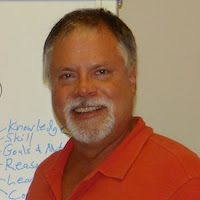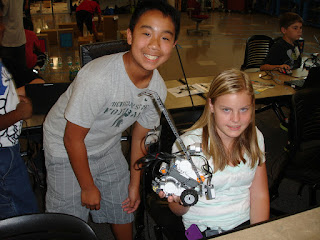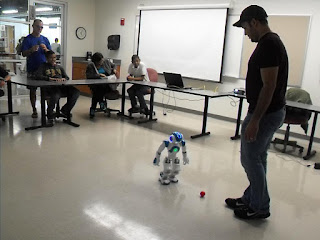
sTEm–at-Work Answer Puzzle #34: Valve Selection for OJ transfer

D.L. Jamerson Elementary School Marks 10 years of Excellence in Engineering and Technical Education
In the 2002-2003 academic year as FLATE was formulating its initial strategy for developing a technical education pathway that would be tailored to Florida’s educational system as well as address modern workforce needs, the Pinellas County School district contacted FLATE with an interesting challenge. Their objective was to bring engineering into the elementary school environment as a viable way to strengthen STEM education and provide both rigor and relevance to the curriculum. Douglas L. Jamerson (DLJ) Elementary School requested that we partner with them on this U.S Department of Education funded initiative. The result of that collaboration was the DLJ Elementary Center for Mathematics and Engineering in St. Petersburg Florida.
initial planning period, he gathered a group of gifted teachers that were willing to explore a new way to teach elementary school students. While the school campus was being physically prepared to open, this group worked on opening a school that would present this new engineering based learning experience. They met weekly with FLATE for professional development, to discuss and develop a curriculum while spending the time in between integrating these suggestions into an elementary engineering curriculum that would be used in all of the subjects to be taught every day, all year long.
two classes at each grade level. Granted the student test scores that first year were nothing to write home about and the school received an average rating. However, by the fourth year of operation, starting with K, first, second and third graders moving into fourth and fifth grade, DLJ’s test scores and school rating started going up. The school never looked back. Today, DLJ is an A rated elementary school, and its reputation has spread across the state and in the nation. For our readers in elementary education interested in blending engineering into your teaching day, check out their website, give them a call, or just Google D.L. Jamerson Elementary. You will be pleased with the results.
Last month DLJ Elementary celebrated its 10th anniversary. This was an all-day event culminating with an open house and evening picnic for the public. That single event drew more than 700 people from the St. Petersburg neighborhoods the school services. Attendees included former DLJ students and teachers, as well as city and state dignitaries. So happy anniversary D.L. Jamerson Elementary School! Your first 10 years were a whopping success! Who knows what the next 10 years will bring, but for Jamerson it is bound to be good.
NAM’s Manufacturing Institute Recognizes Eleven Florida Colleges Offering ET Degree
Association of Manufacturers’ Manufacturing Institute has included 11 colleges from the Florida State College System as charter members of its “M-List” that recognizes schools for excellence in manufacturing education. The FL DOE also indicated that the Manufacturing Institute acknowledges Florida as the national leader with the most schools on the list. The 11 Florida colleges that made the “M-List” are: Brevard Community College, Broward College, College of Central Florida, Florida Gateway College, Florida State College at Jacksonville, Hillsborough Community College, Pensacola State College, Polk State College, St. Petersburg College, State College of Florida Manatee-Sarasota, and Tallahassee Community College.
Alessandro Anzalone, Mike Cannon, Eric Roe, Brad Jenkins, Adrienne Gould-Choquette and Bruce Batton from the Florida colleges on the “M-List”. Without their efforts, none of the colleges would be on the list. In addition, FLATE anticipates that Florida’s impact on the “M-List” will go up because the ET degree has very recently been adopted by Gulf Coast State College and Northwest Florida State College. Finally, a very special “thank you” to Eric Owens, senior director of adult and career education at FL DOE for his ongoing support of our work. Without his help, the ET degree would have never gotten off the FLATE drawing board. Thanks gang!
Science Saturday “Rockets & Robots” Presentation Sparks Interest in Science
Earlier this year, we brought you a story about Science Saturdays—an outreach initiative spearheaded by Florida Institute for Human & Machine Cognition (IHMC) with offices in Ocala and Pensacola, FL. To recap, the Center‘s community outreach efforts focuses on making science more accessible to people of all ages. According to Dr. Ursula Schwuttke, development director for the Ocala educational outreach program says the Center‘s community outreach efforts focus on making science more accessible to people of all ages. The emphasis of the Science Saturday series, according to Schwuttke “is to provide hands-on learning experiences where youth interact directly with scientists, doing enjoyable and exciting activities that engage the mind.” In Ocala, from September to May, two free Saturday sessions are offered for Marion County students, grades 3-5.
& robots at its facility in Ocala, FL. A total of 60 students attended the session, with 30 attendees in each of the two sessions. Dr. Dave Atkinson, senior research scientist at IHMC in Ocala led the session which took place on a “Martian landscape”. Working in teams of five, attendees simulated a robot with the five functions of vision, control, mobility, left arm, and right arm. Schwuttke says these topics are important in terms of developing general knowledge and exposure to scientific topics. The exercises, during the rockets and robots presentation, were an extension of these objectives. In that, they showcased among other things difficulties in coordinating the functions a robot performs. Schwuttke hopes the rockets & robots presentation creates an excitement for science among students and exposes them to robots and their application in everyday life.
opportunities. IHMC partnered with FLATE, the Florida regional center of excellence in manufacturing, for a second summer of robotics camps for middle and high school students this summer. The robotics camp fever has spread in the central Florida region with Workforce Connection (Marion, Levy and Citrus county) offering camps in Citrus and Levy counties, all based on the FLATE robotics camp curriculum. Robotics is a really good tool to get kids interested in STEM.
Students & Educators Share Best Practices and Grow Innovation at the Florida STEM Forum
sponsored a full day STEM Forum for industry, educators and students at the 21stFlorida Sterling Conference held in May, in Orlando, FL. The STEM Forum titled, Share Best Practices: Grow Innovation, served as a collaborative event to share, identify best practices and innovative approaches to prepare students primarily for high-tech manufacturing and STEM-related jobs. Attendees included a cross section of individuals from large and small manufacturing firms including Baldrige recipients, manufacturing and workforce associations, leaders from community colleges, state colleges, and career academies, and the Florida Chamber of Commerce.
FLATE also helped coordinate the Career Academy Panel Best Practices. The panel was facilitated by Dehryl McCall, director of Workforce Florida Inc., and included a cross section of educators from across the state. Kathy Schmidt, director for career & technical education (CTE) for St. Lucie County Public Schools provided an overview of CAPE academies, their current impact and future contribution to CTE in Florida. Dale Toney, Greg McGrew—a FLATE awardee, and Russ Henderlite, instructors at the engineering academies at Marion Technical Institute, Lakewood Ranch High School, and Treasure Coast High School respectively, provided information and best practices about the engineering programs/specializations at each of these high schools. They also briefed attendees about industry certifications offered at each of the schools, and local industry partners’ role in providing students with hands-on experience. “I was intrigued by the schedule component that Polk State College does, and will be looking into workforce connection for internships” Toney said.
Discussions were primarily focused on those areas of STEM education and training relevant to career
academies in Florida, talent supply they are providing, skills/certifications earned, and where students are finding employment. “The Panel discussions helped me understand the value of earning industry certifications like the MSSC certification” said James Dempsey, an engineering student at Marion Technical Institute in Ocala, FL. Dempsey who has two MSSC Certifications in Safety Awareness and Quality Assurance plans on pursuing a degree in robotics at Florida Technical College.
Examining the Overarching Applications and Integration of Robots and Robotics Technology
Robots offer a single platform to teach STEM subjects both individually and/or integrated together. There
are a lot of fundamental processes and principles of STEM at multiple levels in designing, building and programming robots. Problem and project-based learning come to life when using robots to help students learn. In the context of this integrated, contextual learning, students can learn by discovery and develop creativity necessary for invention. Robotic platforms require students and teachers to develop strong soft skills including communication skills and teamwork. Robots are also ripe platforms for developing trouble-shooting skills.
Robots can now be found everywhere in many industrial and business sectors with innumerable applications. Close your eyes and just imagine a job you don’t like to do because it’s tedious, repetitive, dangerous, or just plain boring! On that same token, what do robots do for manufacturers? From the moment materials arrive to be processed until the final products leave the manufacturing plant, robots help get many jobs done. They are used for stacking and retrieving components for assembly as well as for storing final product inventory in warehousing settings. They do welding, assembly, inspections, filing, packaging and labeling. Robots can be designed to do almost any task you can imagine.
Valpak in Pinellas County has a state-of-the-art “warehouse” where bundles of sorted blue envelopes wait for their mail date to arrive. Once these are picked up, an unmanned robotic vehicle makes it way down a long narrow aisle to collect the desired pallet. The box is retrieved from storage by another robot that identifies the pallet, moves it from the shelf to the vehicle, and confirms if it is the correct pallet and vehicle using tracking devices. The unmanned vehicle delivers the goods to a conveyor, which takes it to the loading docks. Technically, this is called an “automated storage and retrieval system,” or ARS with robots being just one of the key components to make it all happen.
Farther south on Florida’s east coast, Hoerbiger Corporation, is just one of many manufacturers that have recently installed robotic assembly lines. One such line assembles valves that are part of the compressor system of ThemoKing refrigerated vehicles. Components produced in other parts of the facility, make their way to this cell where five robotic arms, multiple part feeders, sensors work in unison to assemble all parts. It’s amazing and mesmerizing to watch.
The USF CAMLS (Center for Advanced Medical Learning and Simulation) in Tampa is teaching surgeons
the latest techniques for robotic surgeries. In Ocala and Pensacola, the Institute for Human and Machine Cognition (IHMC) pioneer technologies aimed at leveraging and extending human capabilities, often with robotic applications. Every university in the state has research engineers and scientists working in centers focused on some aspect of robotics including machine intelligence, nonlinear controls, and robotic mechanical systems. Material science and technology is another important aspect of robotics that focusses on determining the best material to use for a robot doing a particular job.
There are many more examples of robotic research and production activity in Florida. Given its prominence, it is important to help students understand that robots are not just for fun. They can be used as a platform to teach STEM concepts, and as such, comprise growing numbers of career opportunities that support Florida manufacturing businesses. Industrial robots have also raised the bar for many manufacturing jobs and careers. Manufacturing technicians today need to have a working knowledge of how different machines work independently and/or in cohort with each other and with people via computer codes. Students can focus their studies on the mechanical parts, electrical parts, or the communication part of a robot.
Now that you are well versed with robots, the technology behind them, and their applications, I invite you to read rest of the stories in this special, robotics-centered edition of the FLATE Focus. From our report on national robotics week, to our observations on what it takes to be a 21st century robotics technician we explore every aspect of robotics and its impact on students, educators as well as industry. For those inclined toward renewable and alternative energy related news bytes, tune in to our story about upcoming energy camp offerings, or sign up and go green at the “Greentech for Girls” summer camp for teachers. Before time and space runs out, do consider robotics camps for your students, and as always take a stab in solving our sTEm puzzle of the moth. These and many more stories in this edition of the FLATE Focus.
Relevancy of Robotics in sTEm Education
Part of FLATE’s National Science Foundation mission is to provide education and experiences promoting
Florida advanced manufacturing college and career pathways, and for many students, the educational punch packed by robotics camp is an ideal way to jumpstart the process toward interest in adding more STEM subjects in school. As well, while math and science subjects abound, technology and engineering subjects, especially in middle school, may be harder to find. Robotics camps and programs are stepping up to fill the void in technical and engineering education (the T & E side of sTEm), for the average middle school student. Parents of summer campers have let FLATE know, through surveys, that schools are not offering enough technology, engineering, and robotics curriculum and coursework, and parents wish this would change. In response to this articulated need, FLATE has developed curriculum focused on industry connected high tech manufacturing scenarios (based on real Florida companies) and also uses summer robotics camps and open house events in HCC’s high tech engineering technology lab to raise awareness about technology and engineering college and careers using robots as one hook to engage and interest students.
Early exposure to robotics through camps, competitions, and sTEm programs, especially if not offered as part of traditional school curriculum, introduces students to the world of automation and provides the opportunity to explore high tech industrial careers and inventive concepts and applications. In speaking about robotics camps, Dr. Row Rogacki, Institute for Human and Machine Cognition, believes camps “meet a real need for local students interested in technology.” Indeed, school budgets may present an obstacle for providing state-of-the art “hands on experiences” using equipment in the classroom, and this has contributed to the technology and engineering gap in secondary technology education. New models have high schools working with colleges for laboratory resource sharing, dual enrollment, and partnerships with vendors.
Another important consideration for promoting technology relevant robotics curriculum in schools is
introducing middle and high school teachers to advanced technology curriculum, such as 3-D modeling, and providing teachers with the background, learning resources, and partnerships they need to provide relevant sTEm curriculum using robotics and automated processes. To this end, FLATE hosts engineering technology summer institutes, summer camps for teachers, and sTEm workshops for teachers. Teacher workshops in recruitment strategies for girls to STEM curriculum and “Green” technologies are popular with advisors as well as teachers. As a parent recently shared, “[robotics] is a program that should and could be incorporated in the school systems – it is learning, fun, and hands on which is needed in our students education.” Involving all levels of education providers, as well as parents in awareness of the relevance of technology, engineering, and robotics is critical to supplying tomorrow’s high tech workforce.
To register for FLATE’s 2013 Summer Institute, contact Dr. Marilyn Barger at barger@fl-ate.org,. For more information about FLATE’s 2013 Summer Camp for Teachers, GreenTech, contact Dr. Marie Boyette at mboyette3@hccfl.edu. To register for the 2013 “All Girls” and other robotic camps, visit our website at https://www.fl-ate.org/projects/camps.html, or contact Desh Bagley, outreach manager at bagley@fl-ate.org.
What It Takes to Be a Robotics Technician: The Nuts & Bolts
question for students and parents attending the recent FLATE’s national robotics week open house, FLATE’s Executive Director, Dr. Marilyn Barger, started with the O*Net site for robotics technicians. The official NAISC code is 17-3024.01—Robotics Technician, and the short (but official) definition of this occupation is someone who builds, installs, tests, and/or maintains robotic equipment, or related automated production systems.
 statements in the following categories: tools and technology; knowledge; skills; abilities; work activities; work context; job zone; education; interests; work styles; work values, and related occupations. There are also links to job openings and job search engines as well as national wage data. Click here to go to the robotics technician page. There is a lot more information that you can download if you look behind the “details” tab. This tab also reveals how important and how frequent the various work activities are.
statements in the following categories: tools and technology; knowledge; skills; abilities; work activities; work context; job zone; education; interests; work styles; work values, and related occupations. There are also links to job openings and job search engines as well as national wage data. Click here to go to the robotics technician page. There is a lot more information that you can download if you look behind the “details” tab. This tab also reveals how important and how frequent the various work activities are.| click to enlarge image |
Starting with salary and wages, and employment, you can find out that the average 2012 annual wage for
this occupation is $51,820, and that there are approximately 16,000 people in the U.S working in that occupation. Not surprisingly, the 3,200 openings anticipated in this decade (2010-2020) are primarily in manufacturing and scientific and technical services. There is also a link to a much related occupation of electromechanical technicians and nearly 70% of the 16,000 robotics technicians have an Associate’s degree. Students can find good jobs as robotics technician after completing an Associate’s degree in engineering technology in Florida with one of several specialized tracks: advanced manufacturing; electronics; or digital design, or others at a state or community college near you
For more information visit www.madeinflorida.org, and www.fl-ate.org, or contact Dr. Marilyn Barger, executive director of FLATE at barger@fl-ate.org, and Dr. Marie Boyette, associate director of FLATE at boyete@fl-ate.org.
sTEm–at-Work Puzzle #34: Valve Selection for OJ transfer
The technician installed the “U-Becth-Em V222. YES or NO.
Submit your answers under this blog post, or post it on www.fl-ate.org.
Robotics Open House Serves as a Hotspot for STEM & Robotics Enthusiasts
Indeed robots are everywhere, and there is a national as well as regional “push” to get students and the
community at large engaged in STEM using robotics as a common platform. Given this trajectory in latest technological trends, FLATE—the National Science Foundation Center of Excellence in manufacturing at Hillsborough Community College—recently partnered with local engineering and robotics clubs in Tampa bay to celebrate national robotics week. The event was featured in National Robotics Week calendar, and showcased the various dimensions of robots and robotics technology at play. Robots project a fun side of engineering, says Juan Calderon, an electrical engineering student conducting research at the bio robotics lab at the University of South Florida in Tampa. Robots serve as a “hook” in helping steer students’ interest in science, technology, engineering and mathematics (STEM), said Juan. He, along with his fellow researcher, Johann another USF student who will also be serving as a robotics instructor at the FLATE robotics camps this summer, were in charge of the NAO robot—a humanoid robot—interactive demonstration at the robotics open house.
FLATE’s robotics open house served as a hotspot for STEM and robotics enthusiasts and brought students, educators, parents and industry professionals from across the Tampa bay region. Julia and Dillon
Perrigault-eng, were among those who were excited seeing the NAO robot in action. “Robots are cool” said Julia. Dillon who aspires to be an engineer says he loves robots as “they can be programmed to do anything humans want them to do.” Haven Rubellios and Mya Arong, 5th graders at Morgan Woods Elementary school were excited to see robotics at play. “We’re like little engineers building robots, problem solving, and working as a team” Mya and Haven tried their hand at the bottle touch challenge, and learned about rotations, speed and distance which they say will help while competing in regional robotics competition later in the year. Trey and Bradley share a similar opinion about robots. “I have always loved robots, and want to build one when I grow up” said Trey. Bradley and Trey who plan on attending FLATE’s robotics camp this summer says the open house gave them a chance to see how to build electric cars, their engines, and learned about 3D printers. The fun part of their day, they said, was watching the robotic arm, which according to Trey has real-world applications in terms of using for excavations and deep sea explorations.
The robotics open house was an educational experience, not only for first timers, but for returning campers like Colton Lewis. “Robots have always fascinated me. Programming is challenging but fun.” Colton who wishes to pursue a career in engineering for the military, has attended all of FLATE’s robotics introductory and advanced camp. He says the experience helped him understand advances in technology and the options that are available to him, and developed problem-solving and critical thinking skills which according to Colton are “keys to succeeding in STEM.” He is currently enrolled in FLATE’s high school camp this summer, and recently won the Florida state STEM fair competition.
In addition to the NAO robot demonstration, attendees also got to see first-hand use and integration of
robotics/robotics software used by robotics FLL, FTC and FRC teams from local schools. Graham Peterson and Daniel Brown showcased the robot they built for the regional FIRST Robotics Competition (FRC). “We used a lot of industry level electronics to build the robot” said Graham. For programming, they used C++, for drive train they used a four, six wheel set-up. Each of the wheels had a roller on it, with a vector at 45 degree angles so they could effectively maneuver speed and direction.
Graham and Daniel, who are members of the robotics club at Middleton High School and have attended robotics camps from introductory through high school level camps, agree “technical skills are central to any engineering field.” Being part of a larger network of robotics teams have not only helped sharpen their understanding of electronics and programming, but have also helped them strategize and work effectively as a team. They hope their demo will inspire similar interests among fellow students attending the robotics open house to develop/sharpen their technical as well as leadership skills, and motivate them to join local/regional robotics team.
Not to leave parents and educators out, the robotics open house had much to offer to those on the
other side of the continuum. Kristy Long and Carissa Brady teachers at Morgan Woods elementary school in Tampa said the robotics open house gave them “insight into the possibilities,” and what they as educators can do with knowledge of robotics. “Exposure to these technologies equips students with the skills needed for the future workforce” said Kristy. “It develops critical thinking skills, and helps students’ understand real-world applications of what they are doing in class” Carissa said.
Fonda Moore, a career counselor for a local school in Tampa agrees STEM-focused jobs tend to pay higher salaries, and is currently in high demand for skilled/qualified professionals. Moore who was attending FLATE’s open house with her son Julian Moore applauds FLATE and HCC for making these resources and opportunities available to the local community students, educators and parents. STEM jobs are not so much hands-on, as they are minds-on, says Moore. “These jobs help students advance career wise, teaches them life skills as it keeps them stimulated and is the way of the future” Moore said.
For more information on FLATE’s robotics program, contact Dr. Marilyn Barger, executive director of FLATE at barger@fl-ate.org. To enroll in one of FLATE’s, STEMulating robotics camps this summer contact Desh Bagley, outreach manager at bagley@fl-ate.org, or visit www.madeinfolorida,org and www.fl-ate.org.
Terms of Use | Privacy Statement
Copyright © 2025 All Rights Reserved
